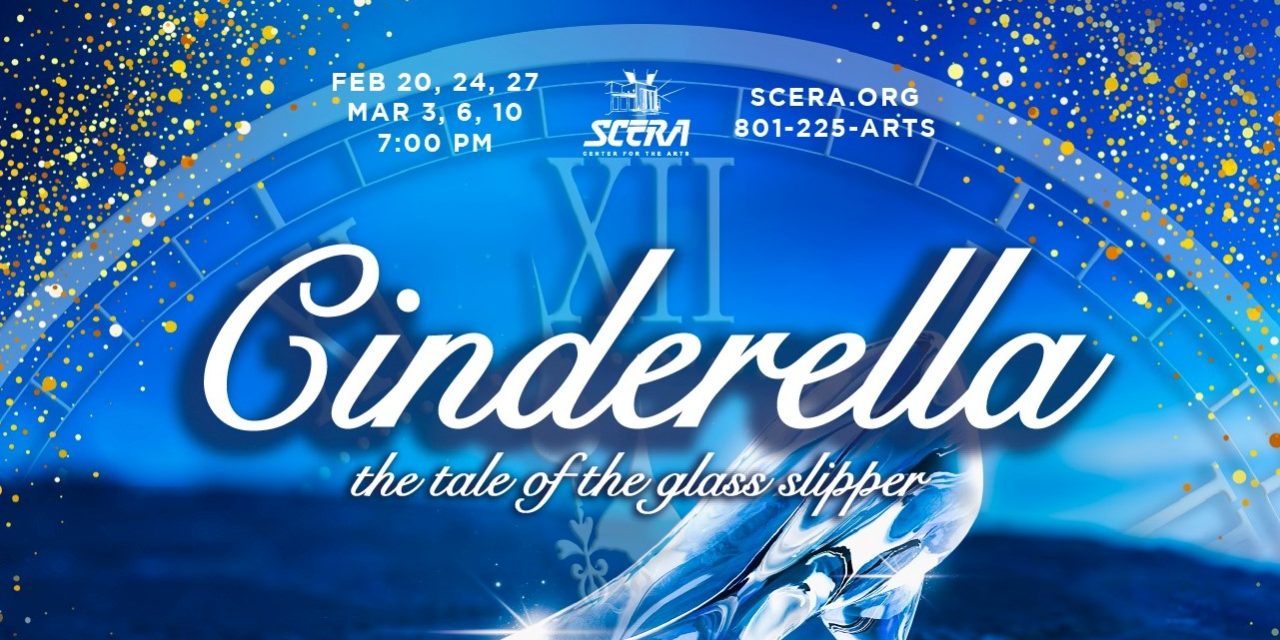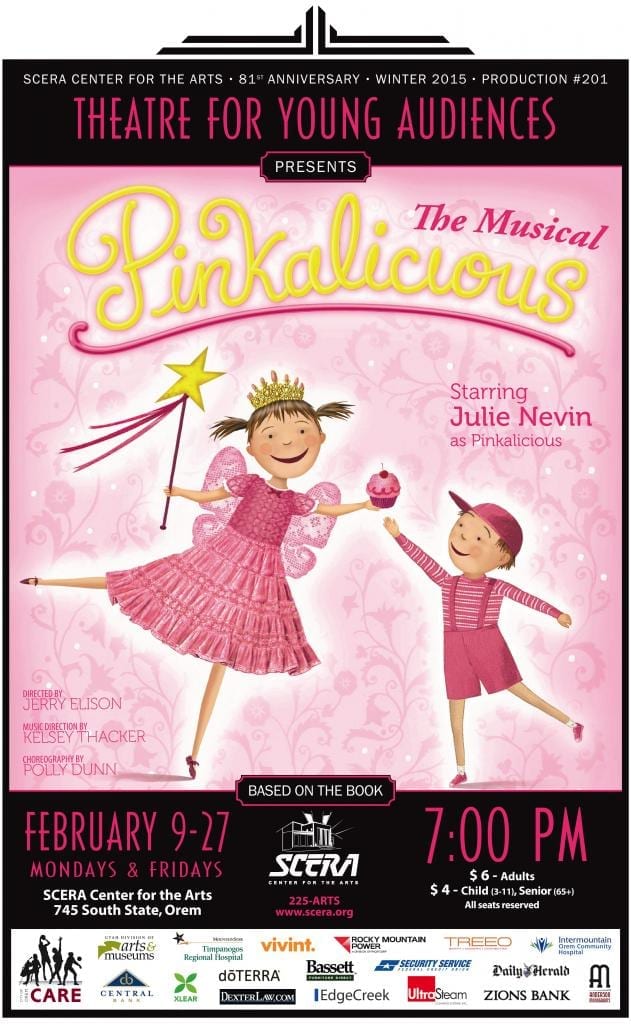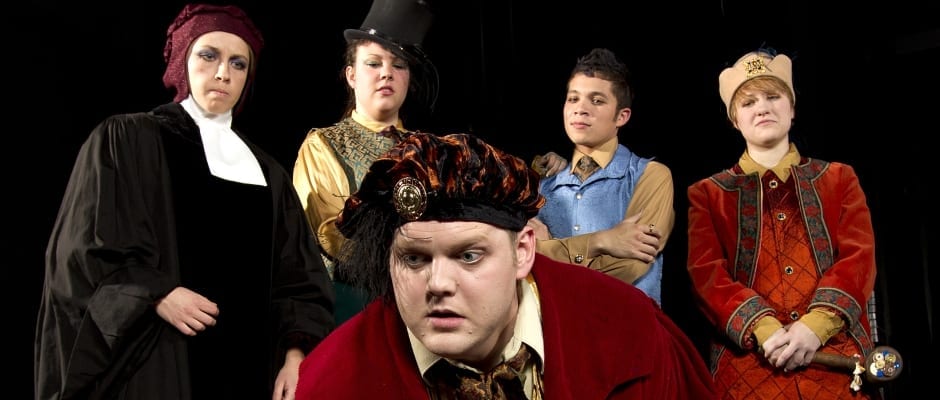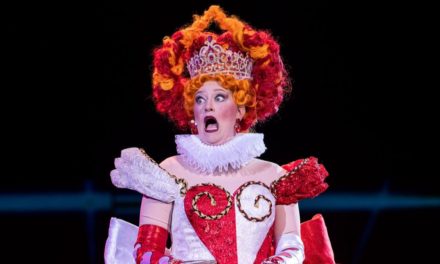OREM — Cinderella might be one the most iconic fairytales of all time. It features a downtrodden young heroine who faces insurmountable odds, the help of magical and non-magical creatures, and ends in the relentless pursuit of love. However, if you’re unfamiliar with the legend of the glass shod heroine, Cinderella: The Tale of the Glass Slipper by Janet Yates Vogt and Mark Friedman may be a confusing foray into this story. Despite a sub-optimal script, however, Director Allison Books put together a perky paced and charismatic production of this timeless romance.
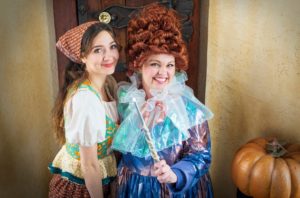
Show closes March 10, 2023.
The set for the production is a picturesque storybook that opens into the humble home of Cinderella (Heidi Hughes) and her buffoonish step-family. Although the panels read backwards with the ending on the left and the title page on audience right, I loved the image created by scenic designer Zippy Hellewell of stepping directly into a storybook world. Similarly impressive was the Prince’s Palace whose central feature of a finely crafted staircase and an ominous clock were well crafted, and brought the audience right into the world of the play. SCERA put great time and care into production elements that illuminated the magic of this story. The horse drawn carriage was stunning as it sparkled with lights and had two beautifully crafted white horses leading Cinderella to her date with destiny. The scenic design was a huge win for this production.
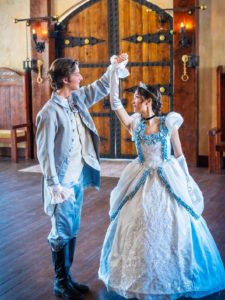
Left to right: Joshua Jones as The Prince and Heidi Hughes as Cinderella
This production features a rat named Putterman (Will Baird) who serves as the story’s narrator and Cinderella’s only true companion through the story. Baird put a great deal of energy into the text’s audience engagement though seemed to miss some of the finer points of truly connecting with a young audience as he blitzed through sections wherein he broke the fourth wall. This was especially true during a song when Cinderella has just watched her ball gown shredded by her shrewish step-sisters, and Putterman tells her that the solution to her problems is to simply giggle and sings a moralistic tune about giggling when one is sad. Toward the number’s end, he gallantly seeks to get the audience to giggle along which had the odd effect of minimizing the concerns of the story’s central character. Baird’s delivery was strong, but the tools he was given to work with were not.
The strongest character performances were those of the, unfortunately, unnamed step-sisters played by Emma Rollins and Lydia Evans. One of the sisters was defined by the trait of being inordinately piggy and wearing a pink dress while the other was simultaneously a germaphobe and chronically hacking up phlegm clad in a garish green gown. The piggy step sister (seriously, don’t know which was played by which) was hysterical in her physical choices and over the top lack of chill about any situation that arose. Her portrayal was played with such high intensity and stakes that she raised the stakes of any given moment. Both sisters were portrayed in a way that brought levity and joy to the show.
There were, however, inconsistencies in either textual interpretation or direction that left me scratching my head. One such choice was that most actors spoke in distinctly non-descript American accents while the prince’s servant Frederick (Ben Holt) spoke with proper British pronunciation, and the Fairy Godmother (Baylie Hendry) had a rich southern drawl. Neither of these choices was inherently flawed, but their juxtaposition made for a murky interpretation of the story’s setting and given circumstances.
The onstage chemistry between Cinderella and The Prince (Joshua Jones) was innocent and sweet. Hughes played a Cinderella who was often aloof, and wasn’t given much context for any of her choices in the text, but she brought the simplicity and sincerity that audiences may traditionally expect from the titular character. When the giggle song doesn’t fully cure what ails Cinderella, she exclaimed in desperation “Oh Putterman, I don’t know if a thousand giggles can make me feel better.”
Not to miss the forest for the trees, this script sabotaged what could have been a stronger performance with better text. With the exception of the Prince knowing Cinderella before she puts on the shoe, there was little that this story brought to the table that isn’t done much better in any of a number of other Cinderella texts. Many of the show’s moments left me puzzling why a character would do or say the things they did other than trying to scratch at surface level interpretations of well known characters and tropes. I wrote about HCTO’s Spookly Script last year doing this, and I again found myself disappointed in a show claiming to be Theater for Young Audiences, but failing to live up to the high standard of quality youth theatre scripts and theatre making.
I will say that I loved SCERA’s commitment to engaging TYA techniques. The actors didn’t shy away from engaging the audience, and after the show they spent quality time with any children who wanted to meet them. The most important audience members for a production like this felt connected to the show, and that was evident in the number of young girls wearing dresses and tiaras to a Monday night play. Ultimately, it was a charming show that was bolstered by two unnamed and unsung heroes in the evil step sisters, and I found myself smiling at the obvious enthusiasm the cast had to make a magical night out.

